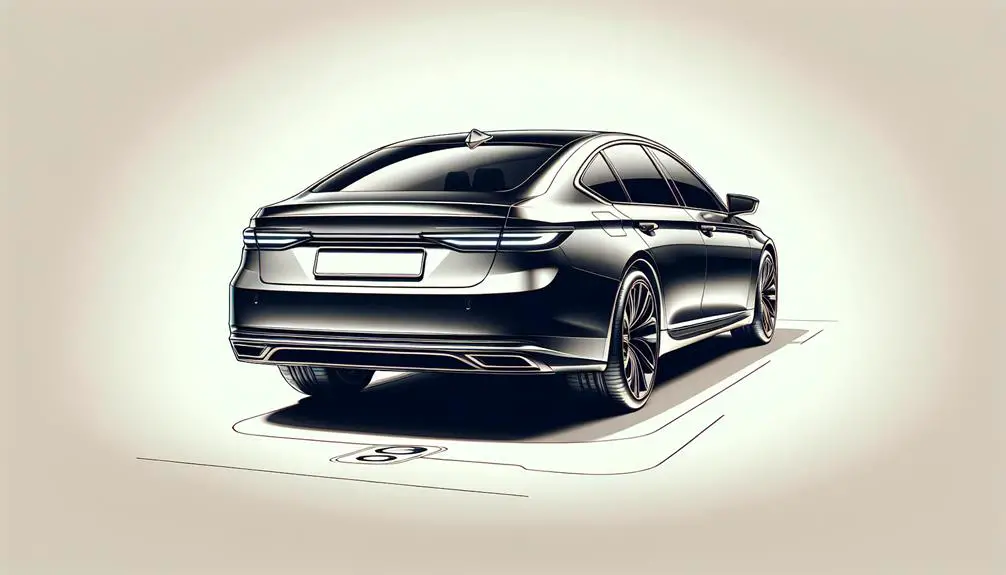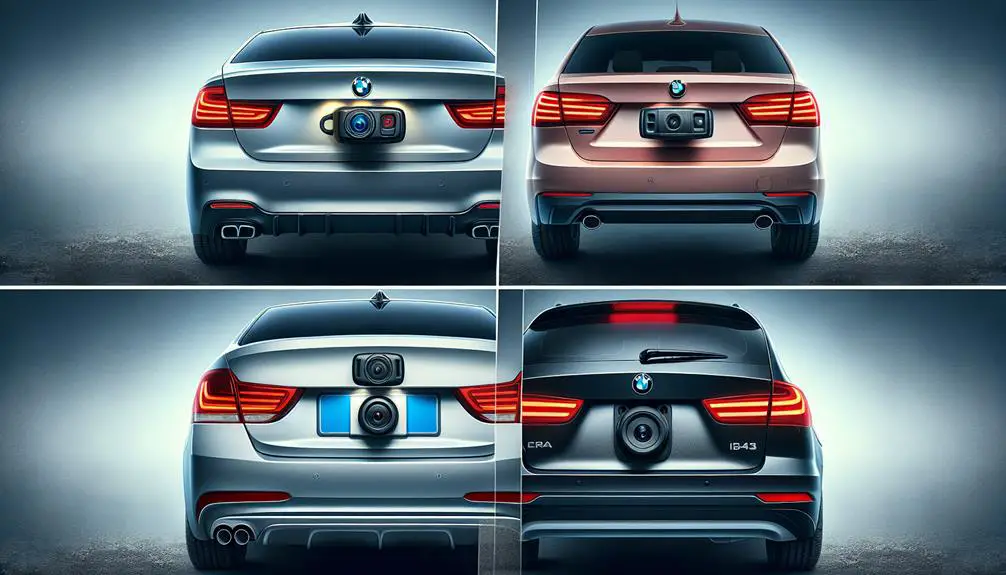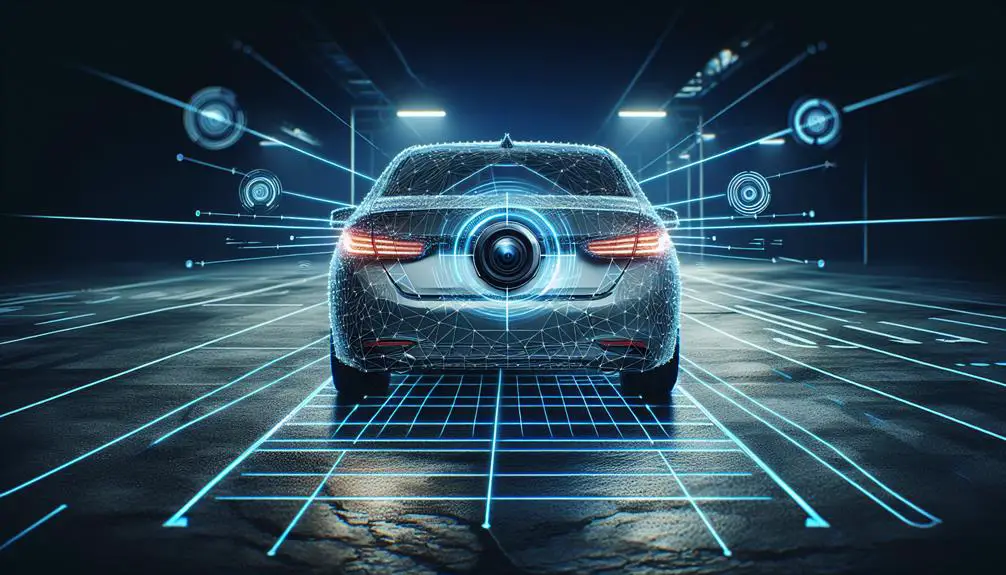The backup camera on a car is typically located near the rear license plate or within the vehicle's tailgate emblem, although its exact location can vary across different makes and models.
When you're parking, reversing, or simply ensuring your path is clear, the role of your car's backup camera becomes undeniable. This indispensable tool is discreetly integrated, offering a clue at the technological details and design priorities of each manufacturer.
If you've ever wondered how to pinpoint your vehicle's backup camera or how its placement impacts its functionality, you're on the cusp of uncovering some intriguing insights.
Understanding Backup Cameras

Backup cameras, your vehicle's essential eyes, greatly improve rearward visibility, making reversing safer and more convenient. You've probably noticed how tricky it can be to gauge the distance between your car and obstacles behind you using just mirrors. That's where these handy devices come in, offering a clear, wide-angle view of what's happening behind your vehicle. They've become so crucial that, as of May 2018, all new cars sold in the United States are required to have them.
You might wonder how these cameras work. They're typically connected to your vehicle's display screen, activating automatically when you shift into reverse. This feature means you don't have to fiddle with buttons or settings when you're trying to back up into a tight parking spot or make sure the coast is clear before reversing. The camera feeds live video to your screen, giving you a real-time view that's especially helpful in low-visibility conditions like nighttime or bad weather.
What's more, backup cameras often come with helpful guidelines on the display. These lines can show the path of your vehicle based on the current steering angle, helping you navigate even the trickiest parking situations. Some systems even go a step further, offering dynamic guidelines that bend as you turn the steering wheel, providing an even more improve guide to where your vehicle is headed.
Typical Camera Locations
While you're considering the convenience of a backup camera, it's vital to know that these devices are most commonly mounted on the rear of the vehicle, typically near the license plate or the trunk latch. This placement isn't arbitrary; it's strategically chosen to give you the best possible view of what's behind your car, minimizing blind spots and maximizing safety.
You'll find that in many cars, the camera is seamlessly integrated into the design, making it almost invisible unless you're looking for it. For example, in sedans, the camera might be tucked right above the license plate, blending in with the car's aesthetics while providing an important function. In SUVs and trucks, the camera may be located a bit higher, near the trunk latch, to compensate for the vehicle's increased height and guarantee a clear, wide-angle view of the rear.
The positioning near the license plate or trunk latch isn't just about the visual field; it's also about protecting the camera from road debris and weather conditions, making sure it remains functional for as long as possible. Manufacturers have put considerable thought into these locations to balance functionality with durability.
Installation Variations

Though most backup cameras are found near the license plate or trunk latch, the installation process can vary significantly depending on the vehicle model and manufacturer.
If you've got a sedan or a hatchback, you'll likely find your backup camera mounted close to the license plate, offering a clear view of what's behind you without much fuss. It's a straightforward spot that doesn't usually require any special adjustments or modifications.
But when you move on to SUVs and trucks, things can get a bit more interesting. Owing to their size and design, the placement can shift. Some models have their cameras integrated into the tailgate handle or positioned above the rear window to provide a wider viewing angle. This is particularly useful for vehicles with a tailgate that might obstruct a lower-mounted camera.
For luxury vehicles and sports cars, manufacturers often go the extra mile to make sure the camera blends seamlessly with the vehicle's design. You might find it hidden within the emblem on the trunk or under a retractable cover that only pops out when you're reversing. It's all about maintaining that sleek look without sacrificing functionality.
No matter where your camera is installed, it's designed to give you the best possible view of what's behind your vehicle. Manufacturers consider the vehicle's design, functionality, and aesthetic appeal to determine the most effective placement. So, while the location may vary, the goal remains the same: to help you reverse safely and efficiently.
Technology and Functionality
In the world of car backup cameras, improvements in technology have greatly enhanced their functionality, making reversing safer and more intuitive than ever before. Now, you'll find that these necessary devices aren't just simple cameras. They've evolved into sophisticated systems equipped with a range of features designed to assist you in maneuvering even the trickiest of parking situations.
First, you've probably noticed that the video quality of backup cameras has greatly improved. High-definition displays make sure you get a clear view of what's behind you, reducing the risk of accidents. This clarity is important, especially in low-light conditions where traditional cameras might struggle.
Additionally, many backup cameras now come with dynamic guidelines. These are the lines that bend and move as you steer, giving you a better sense of direction and space. They adapt based on the angle of your steering wheel, making it easier for you to judge distances and maneuver in tight spaces.
Another notable feature is the integration of sensors with the camera system. These sensors provide audible alerts or visual cues on your display if you're getting too close to an object, enhancing your safety further.
Finally, some backup cameras even offer a panoramic view, using multiple lenses to give you a 360-degree perspective around your vehicle. This all-encompassing view ensures that you're aware of your surroundings, making it simpler to spot obstacles, pedestrians, or other vehicles.
All these advancements mean that relying on your backup camera is more effective than ever. You're not just seeing what's behind you; you're being actively guided and protected by technology designed to make reversing a breeze.
Maximizing Camera Benefits

To make the most of your car's rearview camera, make sure you're familiar with all its features and functionalities. This small device is a powerhouse of assistance when you're reversing, parking, or simply making sure there's nothing behind you that you might hit. Here's how you can optimize the benefits of your rearview camera:
- Regularly Clean the Lens – Dirt, rain, and snow can obscure your camera's view. Make it a habit to wipe the lens gently with a soft, clean cloth whenever you clean your car. A clear lens means a clear view.
- Calibrate the Camera – If your car offers the option, take the time to calibrate your rearview camera. This ensures the guidelines displayed on your screen accurately represent the space around your vehicle. Proper calibration can be the difference between a perfect park and a tight squeeze.
- Use the Guidelines – Most rearview cameras come with on-screen guidelines. These aren't just for show; they're designed to help you gauge distance and align your vehicle when parking or maneuvering in tight spaces. Learn how these guidelines correspond to the actual space around your car, and you'll find parking becomes a breeze.
- Combine Camera Use with Mirrors – Don't rely solely on your rearview camera. Use it in conjunction with your rearview and side mirrors. This all-encompassing approach gives you a fuller picture of your surroundings, ensuring safer maneuvers.
Conclusion
So, you've got the lowdown on backup cameras now. They're usually tucked near your license plate or tailgate, but remember, installation can vary a bit.
These nifty gadgets aren't just about avoiding fender benders; they're packed with tech to make reversing a breeze.
To really get the most out of your camera, make sure you're keeping it clean and checking its angle regularly. Trust me, it'll make parking and backing up safer and less of a headache.